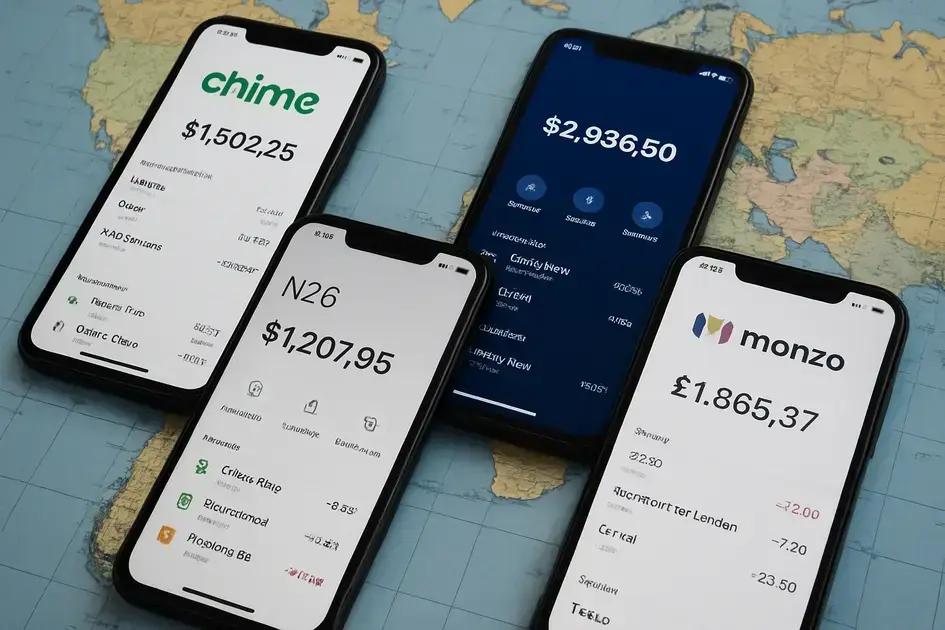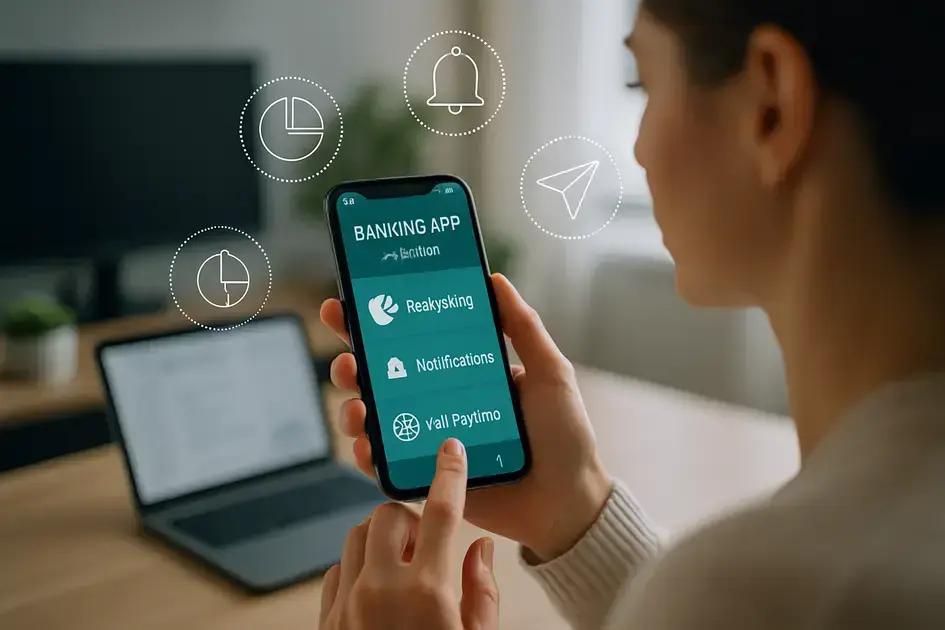Digital-only banks are fully online financial institutions offering lower fees, instant access, advanced security measures, and innovative tools that simplify banking without physical branches.
Digital‑Only Banks have become a hot topic in finance, promising a fresh take on how we manage money. Ever wondered why these banks are gaining so much traction and what it means for your daily banking? Let’s explore what makes them tick and why they might change your financial habits.
what are digital‑only banks and how do they work
Digital‑Only Banks are financial institutions that operate exclusively online, without physical branches. They offer banking services through mobile apps or websites, allowing customers to manage accounts, make payments, and access various financial products anytime, anywhere. These banks use advanced technology to simplify banking processes, providing convenience and speed compared to traditional banks.
They work by partnering with licensed banks or holding their own banking license, complying with the same regulations but focusing on digital channels. Customers typically sign up online by submitting identification documents and verifying their identity through secure methods. Once approved, users can deposit money, transfer funds, and monitor transactions through a user-friendly digital interface.
How digital‑only banks operate securely
Security is a priority; thus, they implement multi-factor authentication, encryption, and real-time fraud monitoring. This protects users’ data and money while maintaining seamless access. The integration of AI and machine learning helps detect suspicious activities quickly.
Technology powering digital‑only banks
The backbone is cloud computing and APIs, which enable these banks to offer flexible services and easily integrate with third-party apps. This allows features such as automated savings tools, instant notifications, and budgeting assistance, enhancing the overall user experience.
By eliminating physical branches, digital‑only banks reduce operating costs and pass savings on to customers through lower fees and better interest rates. Their innovative approach is reshaping how people interact with their finances daily.
key benefits of choosing a digital‑only bank
Choosing a digital‑only bank offers several important benefits that appeal to modern customers seeking convenience and innovation. One key advantage is 24/7 accessibility. You can manage your finances anytime through an app or website, eliminating the need to visit a physical branch or adhere to banking hours.
Lower fees and better rates
Digital‑only banks often have lower operating costs since they don’t maintain branches. These savings usually translate into lower fees and more competitive interest rates, helping customers keep more of their money.
Faster services and instant notifications
Transactions such as transfers, bill payments, and deposits happen swiftly. Many digital banks provide instant alerts, enabling you to track spending and spot any unusual activity right away, boosting control and security.
Innovative tools for money management
They offer smart budgeting features, automated savings, and spending analysis directly within the app. These tools help users make better financial decisions without extra effort.
Seamless integration and user experience
The use of APIs allows digital banks to connect with other financial apps or services, providing a smooth and personalized banking experience tailored to your needs.
Environmental impact is another benefit, as digital‑only banks reduce paper use and the need for travel, supporting eco-friendly practices.
common challenges and limitations of digital‑only banks

While digital‑only banks offer many advantages, they also come with several challenges and limitations that users should consider. One common issue is the lack of physical branches, which means customers can’t visit a bank in person for assistance or cash deposits.
Dependence on technology and internet access
Since these banks operate fully online, a reliable internet connection and a compatible device are essential. Any technical glitches, app crashes, or connectivity problems can disrupt access to banking services.
Limited product offerings
Digital‑only banks may have fewer financial products compared to traditional banks. For instance, they might not offer certain types of loans, mortgages, or investment services, which can limit users seeking comprehensive financial needs.
Security concerns and trust issues
Even with strong security measures, some users may feel uneasy about keeping all banking activities online. Concerns about data breaches, phishing scams, or cyber attacks can affect trust toward these banks.
Customer service limitations
Support is often handled via chatbots, emails, or calls rather than face-to-face interactions. This can lead to slower response times or difficulty resolving complex issues, impacting user experience.
Regulatory and compliance restrictions
Digital‑only banks must comply with strict regulations that may vary by region, potentially affecting the availability of services or features in some locations.
Despite these challenges, many digital‑only banks continue evolving to address user concerns and improve their services.
security measures in digital‑only banking you should know
Security measures are critical in digital‑only banking to protect user data and funds from cyber threats. One key layer is multi-factor authentication (MFA), which requires users to verify their identity using two or more methods, like a password plus a one-time code sent to their phone.
Encryption and data protection
All sensitive information shared between your device and the bank is encrypted, meaning it’s converted into a secure code that prevents unauthorized access. This includes personal data and transaction details.
Real-time fraud detection
Digital‑only banks use advanced algorithms and machine learning to monitor transactions closely. Suspicious activities, such as unusual spending patterns or login attempts from unfamiliar locations, trigger immediate alerts or account freezes.
Secure app design and frequent updates
Apps are built with security in mind, following strict development standards. Regular software updates patch vulnerabilities and improve protection against new cyber threats.
User education and privacy policies
Banks provide guidance on creating strong passwords, recognizing phishing attempts, and protecting personal devices. Clear privacy policies explain how customer data is used and safeguarded.
Together, these measures help build trust and keep your banking safe in a fully digital environment.
how digital‑only banks differ from traditional banks
Digital‑only banks differ from traditional banks in several key ways, reshaping how customers experience banking services. Unlike traditional banks, digital‑only banks operate entirely online without physical branches, allowing for greater convenience and accessibility through mobile apps and websites.
Cost structure and fees
Digital‑only banks typically have lower operating costs as they don’t maintain branches or large staffs. These savings often result in lower fees for customers, including no monthly maintenance fees, reduced ATM charges, and better interest rates on savings.
Speed and user experience
Transactions like transfers, deposits, and payments happen instantaneously or much faster than in traditional banks. The interfaces are often more intuitive, designed for quick navigation and seamless integration with other financial tools.
Product range and availability
Traditional banks usually offer a wider range of services such as mortgages, business loans, and investment products. Digital‑only banks may focus mainly on checking, savings, and basic credit products, though some are expanding their offerings over time.
Customer support
Traditional banks offer face-to-face interaction and a network of branches for personalized service. Digital banks rely mainly on digital support channels like chat, email, or phone, which can be efficient but lack in-person options.
Regulation and trust
Both types of banks must adhere to strict regulatory standards, but some customers may perceive traditional banks as more trustworthy due to their long-standing presence and physical footprint.
Understanding these differences can help you decide which banking model suits your lifestyle and financial needs best.
top digital‑only banks around the world today

There are several top digital‑only banks making waves around the world, each offering unique features and strong user experiences. For example, Chime in the United States is known for its fee-free banking and automated savings tools, helping customers manage money with ease.
Revolut
Based in the UK, Revolut offers multi-currency accounts, cryptocurrency trading, and budgeting features. Its global reach and innovative products have attracted millions of users worldwide.
N26
This German digital bank focuses on simplicity and transparency, providing free basic accounts and premium options with travel insurance and exclusive partner deals.
Monzo
Also from the UK, Monzo stands out with real-time spending notifications and a vibrant community-driven approach to product development.
Other notable digital‑only banks
Examples include Starling Bank, Wise, and Nubank, each catering to different markets with tailored services and competitive fees.
These banks showcase the global shift towards digital banking and the diverse options available to users seeking flexible and modern financial solutions.
how digital‑only banks impact financial inclusion
Digital‑only banks are playing a vital role in improving financial inclusion by making banking accessible to people who often face barriers with traditional banks. These barriers include living in remote areas, lacking proper identification, or dealing with high fees.
Access through technology
With just a smartphone and internet connection, anyone can open an account, no matter where they live. This removes the need to travel long distances to a physical branch.
Lower costs and fees
Digital-only banks usually have lower fees and minimum balance requirements, making banking affordable for low-income individuals.
Simple onboarding processes
Many digital banks offer easy identity verification through mobile apps, allowing users to sign up quickly without complicated paperwork.
Financial tools for empowerment
Features like budgeting tools, instant notifications, and automated savings help users manage money better and build healthy financial habits.
Support for underserved groups
Digital banks often design products suited for gig workers, freelancers, and others who might not fit traditional banking models, expanding financial services to more people.
By breaking down traditional barriers, digital‑only banks are helping millions gain control over their finances and participate fully in the economy.
steps to open an account with a digital‑only bank
Opening an account with a digital‑only bank is usually a straightforward process designed for convenience. The first step is to download the bank’s app or visit their official website.
Create your profile
You’ll typically need to provide basic personal information such as your name, address, date of birth, and email address. This helps the bank identify you and comply with regulations.
Verify your identity
Next, you usually verify your identity by submitting photos of official documents like a driver’s license or passport. Some banks use facial recognition technology or video calls to confirm your identity securely.
Set up account details
Once verified, you can choose the type of account you want and customize settings such as notification preferences and security features like multi-factor authentication.
Fund your account
Most digital banks allow you to add funds via bank transfer, direct deposit, or linking an external account. This step activates your new account for use.
Start banking
After funding your account, you can access a variety of services, including mobile deposits, bill payments, and budgeting tools through your phone or computer.
Following these steps ensures a smooth start with your digital‑only banking experience.
features and services unique to digital‑only banks

Digital-only banks offer unique features and services designed to cater to the needs of tech-savvy customers and improve banking convenience. One key feature is instant account setup, allowing users to open and start using accounts within minutes without visiting a branch.
Personalized financial tools
Many digital-only banks provide budgeting assistants, spending trackers, and automatic savings programs integrated directly into the app. These tools help users manage their money effortlessly.
Real-time notifications
Customers receive instant alerts on transactions, helping to monitor spending and detect fraudulent activity quickly.
Foreign currency exchange and international payments
Some digital-only banks offer low-cost international transfers and multi-currency accounts, making travel and overseas transactions easier.
Fee transparency and lower costs
These banks are known for clear fee structures, often with no hidden charges, and lower fees compared to traditional banks.
Integration with other fintech services
Using APIs, digital banks often connect seamlessly with investment platforms, insurance apps, and payment systems to provide a comprehensive financial experience.
Accessibility features such as voice commands and screen reader support are also common, ensuring inclusivity.
future trends and innovations in digital‑only banking
The future of digital-only banking is filled with exciting trends and innovations, transforming how people engage with their finances. One major trend is the growing use of artificial intelligence (AI) to personalize banking experiences, offering tailored advice and improved fraud detection.
Expansion of open banking
Open banking allows third-party apps to securely access banking data with user permission, enabling seamless integration with budgeting tools, investment platforms, and payment services.
Use of blockchain technology
Blockchain can improve transparency and security in transactions, offering faster settlements and reducing fraud risks.
Biometric authentication
Fingerprint, facial recognition, and voice identification are becoming standard to enhance security and user convenience.
Embedded finance
Banking services will be integrated into non-bank apps and platforms, such as social media or e-commerce, making financial products more accessible in everyday activities.
Stronger focus on sustainability
Digital banks are adopting eco-friendly initiatives, like paperless statements and supporting green investments, aligning with growing customer demand for responsible banking.
As technology evolves, digital-only banks will continue to innovate, providing smarter, faster, and more inclusive financial services for everyone.
The future of banking is digital
Digital-only banks are changing the way we manage money by offering easy access, lower costs, and smart features. They make banking faster and more convenient for people everywhere.
Even though there are some challenges, ongoing innovations like AI and biometric security will keep improving these services. As digital banking grows, it will help more people participate in the financial world and manage their finances better.
Keeping up with these trends can help you take full advantage of what digital-only banks have to offer, making your banking experience simpler and more secure every day.
FAQ – Common questions about digital-only banks
What are digital-only banks?
Digital-only banks operate entirely online without physical branches, offering banking services through apps and websites.
How do I open an account with a digital-only bank?
You can open an account by downloading the bank’s app, providing personal information, verifying your identity, and funding your account.
Are digital-only banks safe to use?
Yes, they use strong security measures like multi-factor authentication, encryption, and real-time fraud detection to protect your data and money.
What are the benefits of choosing a digital-only bank?
Benefits include 24/7 access, lower fees, faster transactions, personalized financial tools, and eco-friendly practices.
Do digital-only banks offer all the services traditional banks do?
They often focus on basic banking services but may have limited offerings compared to traditional banks, though many are expanding features.
Can digital-only banks help improve financial inclusion?
Yes, by reducing barriers like location and high fees, digital-only banks make banking more accessible to underserved populations.
